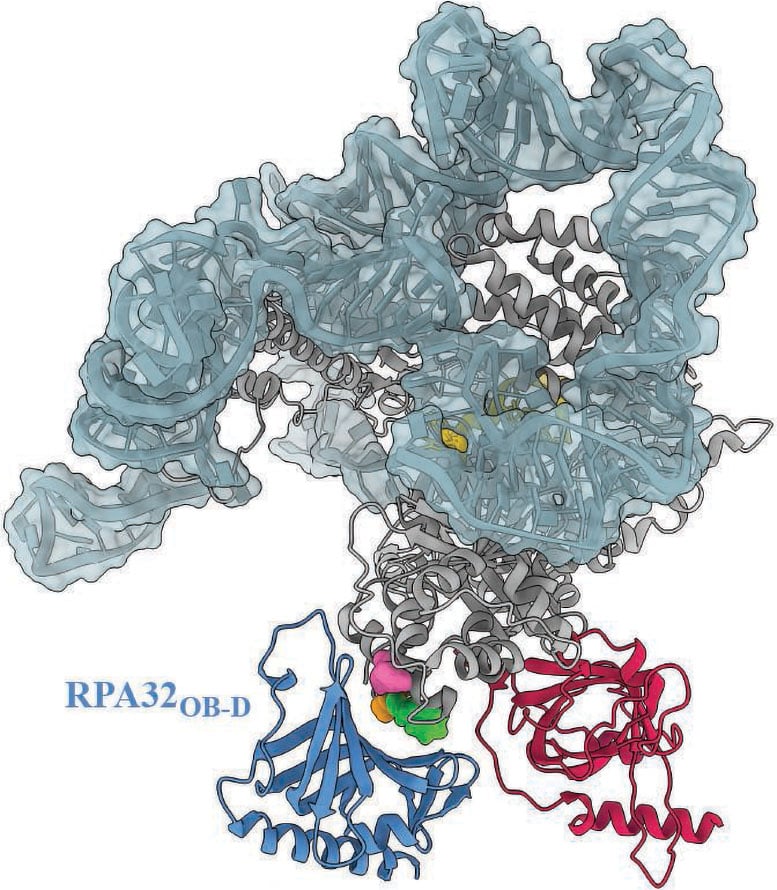A study reveals that a protein called RPA is essential for maintaining chromosome stability by stimulating telomerase.
New findings from the University of Wisconsin-Madison suggest that problems with a key protein that helps preserve chromosome stability may contribute to the development of severe, and sometimes fatal, diseases.
The study, published in Science, offers new clues for identifying mutations in this protein that could help doctors screen for certain cancers and disorders affecting bone marrow.
Chromosomes (bundles of proteins and DNA that hold our genetic blueprint) are shielded from damage by telomeres, the protective caps made of repeating DNA sequences and proteins at each chromosome's end. Although telomeres naturally shorten as we age, disruptions in how they are formed or maintained can destabilize DNA, potentially triggering premature aging and disease.
Researchers in the laboratory of Ci Ji Lim, a biochemistry professor at UW–Madison, worked with colleagues in the university's Department of Chemistry to search for proteins that interact with telomerase, the enzyme that maintains telomeres. They suspected that defects in these associated proteins might contribute to certain illnesses that arise when telomeres become abnormally short.

"This line of research goes beyond a biochemical understanding of a molecular process. It deepens clinical understanding of telomere diseases," says Lim, whose work is supported by the National Institutes of Health.
Discovering RPA's Hidden Role
The researchers, led by graduate student Sourav Agrawal, research scientist Xiuhua Lin, and postdoctoral researcher Vivek Susvirkar, searched for proteins likely to interact with telomerase using AlphaFold, a machine learning tool that predicts the 3D structure of proteins and protein-protein interactions. They found that a molecule called replication protein A (RPA) plays an essential role in maintaining telomeres by stimulating telomerase. RPA's role in DNA replication and repair has long been understood, but its role in maintaining long, healthy telomeres in humans was previously unconfirmed. Guided by their findings from AlphaFold, the team experimentally validated that, in humans, RPA is required to stimulate telomerase and help maintain telomeres.
Their findings, Lim says, have immediate implications for some patients with often fatal illnesses resulting from shortened telomeres, including aplastic anemia, myelodysplastic syndrome and acute myeloid leukemia.
"There are some patients with shortened telomere disorders that couldn't be explained with our previous body of knowledge," explains Lim. "Now we have an answer to the underlying cause of some of these short telomere disease mutations: it is a result of RPA not being able to stimulate telomerase."
A Global Impact and Future Testing
Lim and his team have received inquiries from clinicians and scientists around the world asking if their patients' diseases could be the result of genetic mutations inhibiting RPA's newfound function.
"There are colleagues reaching out from France, Israel, and Australia. They just want to give a cause for their patients' short telomere disease so that the patients and their families can understand what is happening and why," says Lim. "With biochemical analysis, we can test their patients' mutation to see if it impacts how RPA interacts with telomerase, and give the doctors insights into possible causes of their patients' diseases."
Reference: "Human RPA is an essential telomerase processivity factor for maintaining telomeres" by Sourav Agrawal, Xiuhua Lin, Vivek Susvirkar, Michael S. O'Connor, Bianca L. Chavez, Victoria R. Tholkes, Grace P. Tauber, Qixiang He, Kaitlyn M. Abe, Xuhui Huang and Ci Ji Lim, 30 October 2025, Science.
DOI: 10.1126/science.ads5297
This research was funded in part by the National Institutes of Health (R01GM153806 and DP2GM150023), the UW–Madison Office of the Vice Chancellor for Research, the Wisconsin Alumni Research Foundation and UW–Madison Department of Biochemistry.
News
Two New Books From Frank Boehm, NA Founder – To be Released Dec. 2025
Molecular Manufacturing: The Future of Nanomedicine This book explores the revolutionary potential of atomically precise manufacturing technologies to transform global healthcare, as well as practically every other sector across society. This forward-thinking volume examines [...]
What could the future of nanoscience look like?
Society has a lot to thank for nanoscience. From improved health monitoring to reducing the size of electronics, scientists’ ability to delve deeper and better understand chemistry at the nanoscale has opened up numerous [...]
Scientists Melt Cancer’s Hidden “Power Hubs” and Stop Tumor Growth
Researchers discovered that in a rare kidney cancer, RNA builds droplet-like hubs that act as growth control centers inside tumor cells. By engineering a molecular switch to dissolve these hubs, they were able to halt cancer [...]
Platelet-inspired nanoparticles could improve treatment of inflammatory diseases
Scientists have developed platelet-inspired nanoparticles that deliver anti-inflammatory drugs directly to brain-computer interface implants, doubling their effectiveness. Scientists have found a way to improve the performance of brain-computer interface (BCI) electrodes by delivering anti-inflammatory drugs directly [...]
After 150 years, a new chapter in cancer therapy is finally beginning
For decades, researchers have been looking for ways to destroy cancer cells in a targeted manner without further weakening the body. But for many patients whose immune system is severely impaired by chemotherapy or radiation, [...]
Older chemical libraries show promise for fighting resistant strains of COVID-19 virus
SARS‑CoV‑2, the virus that causes COVID-19, continues to mutate, with some newer strains becoming less responsive to current antiviral treatments like Paxlovid. Now, University of California San Diego scientists and an international team of [...]
Lower doses of immunotherapy for skin cancer give better results, study suggests
According to a new study, lower doses of approved immunotherapy for malignant melanoma can give better results against tumors, while reducing side effects. This is reported by researchers at Karolinska Institutet in the Journal of the National [...]
Researchers highlight five pathways through which microplastics can harm the brain
Microplastics could be fueling neurodegenerative diseases like Alzheimer's and Parkinson's, with a new study highlighting five ways microplastics can trigger inflammation and damage in the brain. More than 57 million people live with dementia, [...]
Tiny Metal Nanodots Obliterate Cancer Cells While Largely Sparing Healthy Tissue
Scientists have developed tiny metal-oxide particles that push cancer cells past their stress limits while sparing healthy tissue. An international team led by RMIT University has developed tiny particles called nanodots, crafted from a metallic compound, [...]
Gold Nanoclusters Could Supercharge Quantum Computers
Researchers found that gold “super atoms” can behave like the atoms in top-tier quantum systems—only far easier to scale. These tiny clusters can be customized at the molecular level, offering a powerful, tunable foundation [...]
A single shot of HPV vaccine may be enough to fight cervical cancer, study finds
WASHINGTON -- A single HPV vaccination appears just as effective as two doses at preventing the viral infection that causes cervical cancer, researchers reported Wednesday. HPV, or human papillomavirus, is very common and spread [...]
New technique overcomes technological barrier in 3D brain imaging
Scientists at the Swiss Light Source SLS have succeeded in mapping a piece of brain tissue in 3D at unprecedented resolution using X-rays, non-destructively. The breakthrough overcomes a long-standing technological barrier that had limited [...]
Scientists Uncover Hidden Blood Pattern in Long COVID
Researchers found persistent microclot and NET structures in Long COVID blood that may explain long-lasting symptoms. Researchers examining Long COVID have identified a structural connection between circulating microclots and neutrophil extracellular traps (NETs). The [...]
This Cellular Trick Helps Cancer Spread, but Could Also Stop It
Groups of normal cbiells can sense far into their surroundings, helping explain cancer cell migration. Understanding this ability could lead to new ways to limit tumor spread. The tale of the princess and the [...]
New mRNA therapy targets drug-resistant pneumonia
Bacteria that multiply on surfaces are a major headache in health care when they gain a foothold on, for example, implants or in catheters. Researchers at Chalmers University of Technology in Sweden have found [...]
Current Heart Health Guidelines Are Failing To Catch a Deadly Genetic Killer
New research reveals that standard screening misses most people with a common inherited cholesterol disorder. A Mayo Clinic study reports that current genetic screening guidelines overlook most people who have familial hypercholesterolemia, an inherited disorder that [...]





















